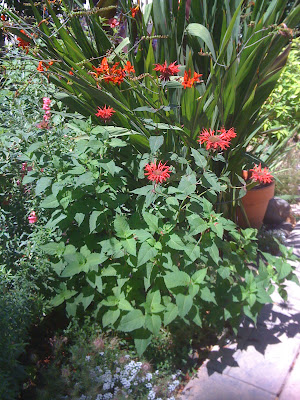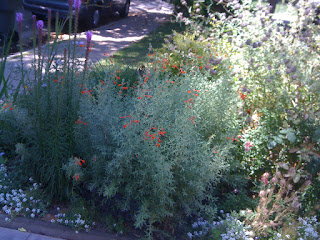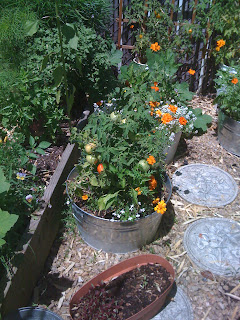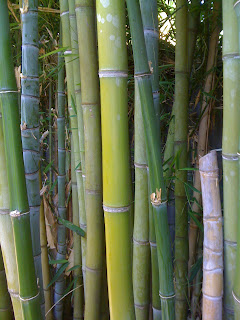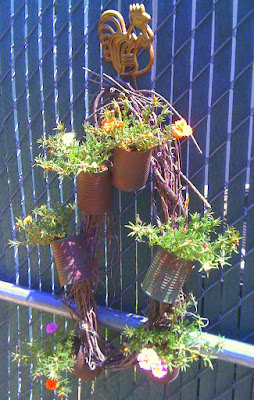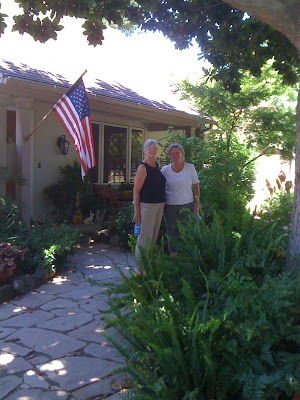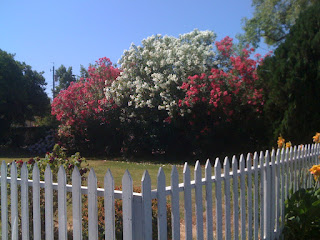Last night's vegetable and flower beds at the fair were spectacularly healthy! But, I get ahead of myself...
Saturday morning, breakfast at High Hand Nursery Cafe. We go here frequently ... great food and great everything else as well (nursery plus the old fruit packing shed now houses an art gallery, a floral shop ... rugs, pottery, sculpture, ironworks, vintage textiles ... it's all just plain lovely!
This plant caught my eye because of its orange flower, but its seeds are what give it its common name, "Blackberry Lily" . They look just like blackberries!
Everything is nice at High Hand, including these beautiful dogs!
Afterwards we had a little stop-off at the Harley shop in Folsom. So, as you can see, it wasn't "all about me!", thank you!
Sunday, we took the doggies to a couple of parks. Squid, our little black dog, got car sick. On me! Pets are just like kids, aren't they!?! Well, it wasn't so bad.
We went to the WPA Rock Garden in William Land Park and saw some beautiful CA natives ...
St. Catherine's Lace, a wild buckwheat, is stately and impressive!
The Matilija Poppy flower (also known as the "fried egg plant") can be up to 9", the entire shrub, 6 -8'!
The California Fuchsia is a hummingbird favorite.
Next we headed for the Capitol Park. We got some coffee at the Capitol Garage and then went to study the trees, like this gnarly Cork Oak,
... but it was hot and we were all thirsty, so tree study wasn't very satisfying.
The treat was the new "We Garden" site created by students and First Lady, Maria Shriver.
In the center of the state capitol grounds, on a hot Sacramento day in the middle of July, the charm of a vegetable garden.
Last night we went to the State Fair. The Farm was my favorite! (and the chickens and bunnies and the baby pigs...)
Lots of crops, looking really good!
Water-wise demonstration gardens with drought tolerant beauties,
and, a clump of sleeping piglets!
Most of us live such citified lives. We're far removed from wide open spaces and farm animals and tractors and dirt between our toes. I've lived in the suburbs or the city all of my life, but in my heart I'm a farm girl.
I'm really proud of our state's agricultural prowess and the fact that we produce and supply about 1/3 of the nation's food supply. California has been the number one food and agricultural producer in the United States for more than 50 consecutive years. There are problems with being such hot stuff, however, that need to be intelligently understood and handled. As a state we're facing issues of illegal immigrant labor, environmental questions regarding insect and disease controls and what kind of fertilizers to use. And then, of course, there's the problem of water!
I think these questions are best understood by people who are connected with the earth, who once in awhile get out of town (!). The beauty of it is, what's not to love about a trip to the country!
Chew on these facts I found online at Beach California (ahem):
- More than half the nation's fruit, nuts, and vegetables come from here.
- California is the nation's number one dairy state.
- California's leading commodity is milk and cream. Grapes are second.
- California's leading export crop is almonds.
- Nationally, products exclusively grown (99% or more) in California include almonds, artichokes, dates, figs, kiwifruit, olives, persimmons, pistachios, prunes, raisins, clovers, and walnuts.
- From 70 to 80% of all ripe olives are grown in California.
- California is the nation's leading producer of strawberries, averaging 1.4 billion pounds of strawberries or 83% of the country's total fresh and frozen strawberry production. Approximately 12% of the crop is exported to Canada, Mexico, United Kingdom, Hong Kong and Japan primarily. The value of the California strawberry crop is approximately $700 million with related employment of more than 48,000 people.
- California produces 25% of the nation's onions and 43% of the nation's green onions.














